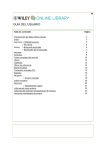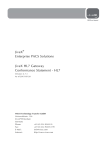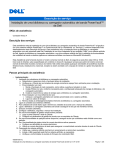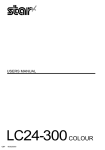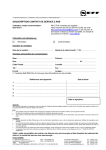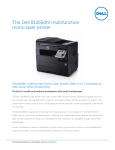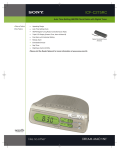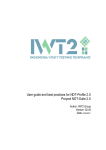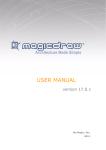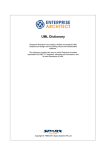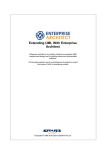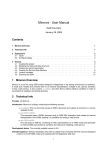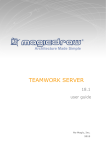Download View/Download - No Magic, Inc
Transcript
CAMEO SOA+TM PLUGIN version 17.0.5 No Magic, Inc. 2013 All material contained herein is considered proprietary information owned by No Magic, Inc. and is not to be shared, copied, or reproduced by any means. All information copyright 2009-2013 by No Magic, Inc. CONTENTS 1 INTRODUCING CAMEO SOA+ 4 2 INSTALLING AND RUNNING CAMEO SOA+ PLUGIN 5 Installing the CameoSOA+ Plugin 5 Sample of SoaML diagrams 5 3 CAMEO SOA+ DIAGRAMS 6 Services Architecture Diagram 6 Service Architecture diagram elements 7 Service Architecture diagram sample 8 Service Structure Diagram 8 Service Structure diagram elements 9 Service Structure diagram sample 9 Service Choreography Diagram 10 Service Choreography diagram elements 11 Service Choreography diagram sample 12 Message Type Diagram 13 Message Type diagram sample 14 Composit Application Component Diagram 14 Composit Application Component diagram elements 15 Composit Application Component diagram sample 16 4 CAMEO SOA+ VALIDATION RULES 5 CAMEO SOA+ STEREOTYPES 6 CAMEO SOA+ TUTORIAL 17 19 21 Step 1. Start modelling 21 Step 2. Modeling Services Architecture 23 Step 3. The Service Structure 26 Step 4. Integration of services 31 Step 5. Validation errors 34 Step 7. The communication structure 36 Step 8. Information exchange 37 Step 9. Interfaces and Participants 43 Conclusions 45 7 INFORMATION AND SUPPORT 46 Bug Report 46 NoMagic Customer Support System 46 Web page 46 E-Mail 46 Frequently Asked Questions 47 3 Copyright © 2009-2013 No Magic, Inc.. 1 INTRODUCING CAMEO SOA+ Cameo SOA+™ leverages the Unified Modeling Language® (UML®) along with the latest SOA modeling standard, SoaML™, to provide both architects and developers an integrated solution for creating optimal SOA architectures and implementations. Cameo SOA+ brings together SOA at both the business and technology levels to address the full spectrum of services. From Enterprise and Business Architectures to implementing, using and composing services on your favorite enterprise service bus (ESB) or application server, this integrated plug-in is versatile enough for both personal and team-based development. SoaML helps create and use services based on new and existing capabilities using composite services. Figure 1 -- SoaML elements modeling using MagicDraw with Cameo SOA+ Cameo SOA+ leverages the latest Model Driven Architecture® (MDA®) standards and technologies making the transition from model to implementation highly automated, reducing implementation and maintenance costs. Cameo SOA+ supports all SoaML diagrams, including Service Structure, Service Choreography, Service Architecture, Message Type, Composite Application Component, Activity, Capability and provisioning. Cameo SOA+ is packaged as a plugin for the MagicDraw tool and is available for purchase separately. The Cameo SOA+ retains all capabilities of award-winning MagicDraw architecture modeling environment adding a SOA specific perspective. The Cameo SOA+ engineer (the specific context of the MagicDraw user interface for SOA modeling) includes SOA specific menus, toolbars, diagrams, specification and user interface. When in the SOA context, we meet the specific needs of the SOA modeler, including the same award winning MagicDraw usability features. This is then extended with the added code generation capabilities of ModelPro™ enabling the full development from model to operating services. 4 Copyright © 2009-2013 No Magic, Inc. 2 I N S TA L L I N G A N D RUNNING CAMEO SOA+ PLUGIN In this section, you will find information on how to install the CameoSOA+ Plugin and how to start working with CameoSOA+ plugin. Installing the CameoSOA+ Plugin To install the CameoSOA+ Plugin, go to the main Help menu and select the command Resource/Plugin Manager. Select the CameoSOA+ Plugin to download and install. After automatic download and installation restart MagicDraw to activate the plugin. More about working with Resource Manager, see MagicDraw User Manual.pdf. If you have already downloaded the CameoSOA+ Plugin, go to the Help main menu and select the Resource/Plugin Manager. Click the Import button to specify CameoSOA+ Plugin file location. After automatic extraction and installation restart MagicDraw to activate the Plugin. To install on Mac OS X, copy the CameoSOA+ Plugin file to the MagicDraw installation folder. Then use the command line to go to the MagicDraw folder and unzip the CameoSOA+ Plugin. Sample of SoaML diagrams SoaML sample is included. You may find the SoaML_Diagrams.mdzip project, with all SOA diagrams in the <MagicDraw installation folder>/samples/Cameo_SOA+. 5 Copyright © 2009-2013 No Magic, Inc. 3 CAMEO SOA+ DIAGRAMS The Cameo SOA+ Plug-in provides different types of diagrams for the SOA architecture and implementation: • "Services Architecture Diagram.", on page 6 • "Service Structure Diagram.", on page 8 • "Service Choreography Diagram.", on page 10 • "Message Type Diagram.", on page 13 • "Composit Application Component Diagram.", on page 14 Services Architecture Diagram The Services Architecture Diagram represents the structure of a services architecture (see Figure 1 on page 8). It puts a set of services in context of each other and shows how participants work together. A Services Architecture is a network of participant roles, which provides and consumes services to fulfill a purpose. It defines for the types of participants and service realizations the requirement, which fulfill those roles. The roles defines the basic function that an entity may perform in a particular context. In contrast participant specify the type of a party that fills the role in the context of a specific services architecture. The participants specifies the type of a party that fills a role inside the services architecture to provide and employ services. The goal of the services architecture is to specify the SOA of the organization, community or process to provide mutual value. 6 Copyright © 2009-2013 No Magic, Inc. 3 CAMEO SOA+ DIAGRAMS Services Architecture Diagram Service Architecture diagram elements Element Notation Description Service Architecture A Services Architecture (an SOA) describes how participants work together for a purpose by providing and using services expressed as service. Participant Part A Participant Part is the type of a provider and/or consumer of services. In the business domain a participant may be a person, organization or system. In the systems domain a participant may be a system, application or component. Agent Part An Agent Part is a classification of autonomous entities that can adapt to and interact with their environment. Service Contract Use Service Contract Use is extended to indicate whether the role to part bindings are strictly enforced or loose. Role Binding A role binding is a mapping between features of the collaboration type and features of the classifier or operation. This mapping indicates which connectable element of the classifier or operation plays which role(s) in the collaboration. Participant A participant is the type of a provider and/or consumer of services. In the business domain a participant may be a person, organization or system. In the systems domain a participant may be a system, application or component. Agent An Agent is a classification of autonomous entities that can adapt to and interact with their environment. Service A Service is the offer of a service by one participant to others using well defined terms, conditions and interfaces. A Service defines the connection point through which a Participant offers its capabilities and provides a service to clients. Request A request defines the port through which a Participant makes requests and uses or consumes services. Generalization A generalization is the relationship from the child element (the more specific element, such as a subclass) to the parent (the more general element, such as a super class) that is fully consistent with the first element and that provides additional information. Realization A realization is a specialized abstraction relationship between two sets of model elements, one representing a specification (the supplier) and the other represents an implementation of the latter (the client). 7 Copyright © 2009-2013 No Magic, Inc.. 3 CAMEO SOA+ DIAGRAMS Service Structure Diagram Service Architecture diagram sample Figure 1 -- Service Architecture diagram sample Figure 1 illustrates a services architecture involving three participants (dealer, manufacturer, and shipper) and three services (Place Order Service, Ship Status Service, and Shipping Request Service). This services architecture shows how a community of dealers, manufacturers, and shippers can work together. Each party must provide and use the services specified in the architecture. If they do, they will be able to participate in this community. This business to business SOA specifies the roles of the parties and the services they provide and use without specifying anything about who they are, their organizational structure, or internal processes. No “controller” or “mediator” is required as long as each agrees to the service contracts. By specifying a ServicesArchitecture we can understand the services in our enterprise and communities in context and recognize the real (business) dependencies that exist between the participants. The purpose of the services architecture may also be specified as a comment. Each participant in a ServicesArchitecture must have a port that is compatible with the roles played in each ServiceContract role it is bound to. Service Structure Diagram A Service Structure Diagram illustrates a Service Contract, defines terms, conditions, interfaces and choreography that interacting participant must agree to (directly or indirectly) for the services to be enacted. The full specification of a service which includes all the information, choreography and any other “terms and conditions” of the service. The basis of the service contract is also a UML collaboration that is focused on the interactions involved in providing a service. A participant plays a role in the larger scope of a Services Architecture and also plays a role as the provider or user of services specified by Service Contracts. 8 Copyright © 2009-2013 No Magic, Inc.. 3 CAMEO SOA+ DIAGRAMS Service Structure Diagram Service Structure diagram elements Element Notation Description Service Contract A Service Contract defines the terms, conditions, interfaces and choreography that interacting participants must agree to (directly or indirectly) for the service to be enacted. Service Contract Use A Service Contract Use is the formalization of a binding exchange of information, goods, or obligations between parties defining a service. Consumer Part A Consumer Part defines the interface and responsibilities of a participant to consume a service. It is used as the type of a Request. Provider Part A Provider Part defines the interface and responsibilities of a participant to provide a service. It is used as the type of a Service. Part A Part of a Service Contract. Role Binding A role binding is a mapping between features of the collaboration type and features of the classifier or operation. This mapping indicates which connectable element of the classifier or operation plays which role(s) in the collaboration. Connector Each connector may be attached to two or more connectable elements, each representing a set of instances. Each connector end is distinct in the sense that it plays a distinct role in the communication realized over the connector. Interface An interface is a specifier for the externally-visible operations of a class, component, or other classifier (including subsystems) without a specification of the internal structure. Service Structure diagram sample Figure 2 -- Sample of the Service Structure diagram The example above shows a ServiceContract which defines the terms, conditions, interfaces, and choreography for the Place Order Service. Further the participants, which must directly or indirectly agree for a 9 Copyright © 2009-2013 No Magic, Inc.. 3 CAMEO SOA+ DIAGRAMS Service Choreography Diagram interaction and enacted the service. A ServiceContract is a binding contract - binding on any participant that has a service point typed by a role in a service contract. Service Choreography Diagram The choreography is a specification of what is transmitted and when it is transmitted between parties to enact a service exchange. The service choreography diagram specifies exchanges between the parties - the data, assets, and obligations that go between the parties. The choreography defines what happens between the provider and consumer participants without defining their internal processes - their internal processes do have to be compatible with their ServiceContracts. 10 Copyright © 2009-2013 No Magic, Inc.. 3 CAMEO SOA+ DIAGRAMS Service Choreography Diagram Service Choreography diagram elements Element Notation Description Lifeline Represents the existence of an object at a particular time. Call Message A call message represents the request to invoke a specific operation. Send Message The send message represents asynchronous signal sending to the target element Milestone A Milestone is a means for depicting progress in behaviors in order to analyze liveliness. Milestones are particularly useful for behaviors that are long lasting or even infinite. Alternatives The interaction operator alt designates that the Combined Fragment represents a choice of behavior. The alternative fragment models if…then…else constructions. Loop A loop node is a structured activity node that represents a loop with the setup, test, and body sections. Option The interaction operator opt designates that the Combined Fragment represents a choice of behavior where either the (sole) operand happens or nothing happens. An option is semantically equivalent to an alternative Combined Fragment where there is one operand with non-empty content and the second operand is empty. Parallel The interaction operator par designates that the Combined Fragment represents a parallel merge between the behaviors of the operands. Break The interaction operator break designates that the Combined Fragment represents a breaking scenario in the sense that the operand is a scenario that is performed instead of the remainder of the enclosing InteractionFragment. Negative The interaction operator neg designates that the Combined Fragment represents traces that are defined to be invalid. Critical Region The interaction operator critical designates that the Combined Fragment represents a critical region. A critical region means that the traces of the region cannot be interleaved by other Occurrence Specifications (on those Lifelines covered by the region). Consider The interaction operator consider designates which messages should be considered within this combined fragment. This is equivalent to defining every other message to be ignored. Ignore The interaction operator ignore designates that there are some message types that are not shown within this combined fragment. These message types can be considered insignificant and are implicitly ignored if they appear in a corresponding execution. 11 Copyright © 2009-2013 No Magic, Inc.. 3 CAMEO SOA+ DIAGRAMS Service Choreography Diagram Element Notation Description Weak Sequencing The interaction operator seq designates that the Combined Fragment represents a weak sequencing between the behaviors of the operands. Strict Sequencing The interaction operator strict designates that the Combined Fragment represents a strict sequencing between the behaviors of the operands. Assertion The interaction operator assert designates that the Combined Fragment represents an assertion. The sequences of the operand of the assertion are the only valid continuations. All other continuations result in an invalid trace. Interaction Use A reference to other interactions such as: communication diagram, sequence diagram and time diagram. Duration Constraint A duration defines a value specification that specifies the temporal distance between two time instants. Service Choreography diagram sample Figure 3 -- Sample of the Choreography diagram The sample of choreography diagram shown on Figure 3 illustrates how contract roles must interact to fulfill service contract. The service contract separates the concerns of how all parties agree to provide or use the service from how any party implements their role in that service, or from their internal business process. The requirements for entities playing the roles in a ServiceContract are defined by consumer and provider used as the type of the role. The consumer and provider types specify the provided and required interfaces that define all of the operations or signal receptions needed for the role it types - these will be every obligation, asset or piece of data that the entity can send or receive as part of that service contract. 12 Copyright © 2009-2013 No Magic, Inc.. 3 CAMEO SOA+ DIAGRAMS Message Type Diagram Message Type Diagram A Message Type is a kind of value object that represents information exchanged between participant requests and services. This information consists of data passed into and/or returned from the invocation of an operation or event signal defined in a service interface. Message Types are used to aggregate inputs, outputs, and exceptions to service operations as in WSDL. Message Types represent “pure data” that may be communicated between parties - it is then up to the parties, based on the SOA specification, to interpret this data and act accordingly. As “pure data” message types may not have dependencies on the environment, location, or information system of either party - this restriction rules out many common implementation techniques such as “memory pointers,” that may be found inside of an application. Good design practices suggest that the content and structure of messages provide for rich interaction of the parties without unnecessarily coupling or restricting their behavior or internal concerns. Message Type diagram elements Element Notation Description MessageTyp e A Message Type is a kind of value object that represents information exchanged between participant requests and services. A Message Type can illustrate a signal, datatype or a class. Enumeration A user-defined data type whose instances are a set of user-specified named enumeration literals. The literals have a relative order but no algebras defined on them. Direct Composition A composition is used for aggregations where the life span of the member object depends on the life span of the aggregate. A directed relationship represents a relationship between a collection of source model elements and a collection of target model elements. Realization A realization is a specialized abstraction relationship between two sets of model elements, one representing a specification (the supplier) and the other represents an implementation of the latter (the client). Generalizatio n A generalization is the relationship from the child element (the more specific element, such as a subclass) to the parent (the more general element, such as a super class) that is fully consistent with the first element and that provides additional information. 13 Copyright © 2009-2013 No Magic, Inc.. 3 CAMEO SOA+ DIAGRAMS Composit Application Component Diagram Message Type diagram sample Figure 4 -- Sample of the Message Type diagram Figure 4 shows a couple of Message Types that may be used to define the information exchanged between service consumers and providers. These Message Types may be used as types for operation parameters. Message Types can have associations with other message and data types. Composit Application Component Diagram A Composit Application Component Diagram specifies the architecture for a particular Participant. It illustrates how sub-participants and external collaborations work together and stand often in relations to a business process. Although it shows connections to external services over services and requests, which allow the implementation of service interfaces. A ParticipantArchitecture describes how internal participants work together for a purpose by providing and using services expressed as service contracts. The participant architecture is a kind of services architecture for a particular participant. By expressing the use of services, the ParticipantArchitecture implies some degree of knowledge of the dependencies between the participants in the context of the containing participant. A participant architecture is similar to the ServicesArchitecture and the similar parts of the descriptions will be not repeated here, for a detailed view look in the description of the ServiceArchitecture diagram. The only difference is that a participant architecture is based on a structured classifier rather than a collaboration and can therefore for external ports that represent interactions with external participants. A Participant may play a role in any number of services architecture thereby representing the role a participant plays and the requirements that each role places on the participant. 14 Copyright © 2009-2013 No Magic, Inc.. 3 CAMEO SOA+ DIAGRAMS Composit Application Component Diagram Composit Application Component diagram elements Element Notation Description Participant A participant is the type of a provider and/or consumer of services. In the business domain a participant may be a person, organization or system. In the systems domain a participant may be a system, application or component. Participant (Component) A Participant Component is the type of a provider and/or consumer of services. In the business domain a participant may be a person, organization or system. In the systems domain a participant may be a system, application or component. Agent An Agent is a classification of autonomous entities that can adapt to and interact with their environment. Agent (Component) An Agent Component is a classification of autonomous entities that can adapt to and interact with their environment. Part Part represents a set of instances that are owned by a containing classifier instance. Service Contract Use ServiceCollaborationUse is extended to indicate whether the role to part bindings are strictly enforced or loose. Request A request defines the port through which a Participant makes requests and uses or consumes services. Service A Service is the offer of a service by one participant to others using well defined terms, conditions and interfaces. A Service defines the connection point through which a Participant offers its capabilities and provides a service to clients. Role Binding A role binding is a mapping between features of the collaboration type and features of the classifier or operation. This mapping indicates which connectable element of the classifier or operation plays which role(s) in the collaboration. Service Channel A communication path between Services and Requests within an architecture. Assembly Connector An assembly connector is a connector between two components that defines that one component provides the services that another component requires. Delegation Connector A delegation connector is a connector that links the external contract of a component (as specified by its ports) to the internal realization of that behavior by the component parts. Realization A realization is a specialized abstraction relationship between two sets of model elements, one representing a specification (the supplier) and the other represents an implementation of the latter (the client). 15 Copyright © 2009-2013 No Magic, Inc.. 3 CAMEO SOA+ DIAGRAMS Composit Application Component Diagram Composit Application Component diagram sample Figure 5 -- Sample of the Composite Application Component diagram Figure 5 shows a participant’s services architecture. The “Manufacturer component” is composed of “Accounting” and “Order Processing.” The “seller” service port on the Manufacturer component shows the external responsibility of the manufacturer, which is then delegated to the accounting and order processing parts. In participant architecture there are frequently services connected between internal roles or between internal roles and external ports. The “Order Fulfillment Service” shows a service that is internal to the Manufacturer while both the “InvoicingService” and “Place Order Service” are delegated from the Manufacturer component to the internal participants, Accounting, and OrderProcessing, respectively. The business process of the manufacturer is the behavior that may be associated with the participant’s services architecture. Each role in the architecture corresponds with a swim lane or pool in the business process. 16 Copyright © 2009-2013 No Magic, Inc.. 4 CAMEO SOA+ VA L I D A T I O N R U L E S The CameoSOA+ Plugin includes a list of already existing validation rules, which check if the appropriate parameters are defined. All validation rules that are included in CameoSOA+ Plugin are listed in table below. TABLE 1. Cameo SOA+ validation rules for SoaML models Constrained Name Constrained Element Error Message Abbreviation port type must correspond role type Property Port with property type must exits PortType hasPortsForAllBoundRol es ServiceArchitecture Each participant in a Services Architecture shall have a port for each role binding attached to that participant. PA isActive Agent Agents should always be active. The property isActive must always be true. AGENT_ACTIVE noOwnedBehaviors MessageType Message Type cannot contain owned behaviors. MType_cannot_contai n_ownedBehaviors noOwnedOperations MessageType Message Type cannot contain owned operations. MessageType_cannot _contain_ownedOper ations noRealizedUsedInterface Participant A Participant cannot realize or use Interfaces directly, it must do so through Services and Requests. Participant_cannot_re alize_or_use_Interfac es_directly partsAreInterfaces ServiceInterface All parts of a ServiceInterface must be typed by the Interfaces realized or used by the ServiceInterface. ServiceInterface_part s_must_be_typed_by _realized_or_used_int erfaces. partsCompatibleWithRol esForCollaborationUse ServiceContract All parts connected to CollaborationUse must be compatible with the roles they are bound to in a strict services architecture. SA portTypes Participant Participant ports must be of type Request or Service. Participant_capabilitie s_must_be_provided_ through_some_Servic e_and_needs_must_ be_consumed_throug h_some_Request. publicAttributes MessageType Message Type attributes must be public. MessageType_All_ow nedAttributes_must_b e_Public 17 Copyright © 2009-2013 No Magic, Inc. 4 CAMEO SOA+ VA LIDATION RULES Constrained Name Constrained Element Error Message Abbreviation requestType Request Request type must be Interface or ServiceInterface. RequestType serviceChannelEndsCom ServiceChannel patible The Request and Service ports must have compatible types SC serviceChannelEndTypes ServiceChannel One end of a ServiceChannel must be a Request and the other a Service in an architecture. SC Service type must be Interface or ServiceInterface. ServiceType serviceType NOTE 18 Service For more informations about validation rules, see “MagicDraw UserManual.pdf”. Copyright © 2009-2013 No Magic, Inc.. 5 CAMEO SOA+ ST E R E O T Y P E S The CameoSOA+ Plugin includes Stereotypes, which will be illustrate in the following table with a short documentation which describes them. TABLE 1. SoaML profile stereotypes Stereotype Documentation Agent An Agent is a classification of autonomous entities that can adapt to and interact with their environment. It describes a set of agent instances that have features, constraints, and semantics in common. Agents in SoaML are also participants, providing and using services. Attachment A part of a Message that is attached to rather than contained in the message. Capability A Capability is the ability to act and produce an outcome that achieves a result. It can specify a general capability of a participant as well as the specific ability to provide a service. Collaboration Abstract stereotype for Service Contract and Service Architecture common features. Consumer Defines Interface for consumer role in Service Contact. Expose A dependency between a service interface and a capability. The service interface exposes the capability. MessageType The specification of information exchanged between service consumers and providers. Milestone A Milestone is a means for depicting progress in behaviors in order to analyze liveness. Milestones are particularly useful for behaviors that are long lasting or even infinite. Participant A participant is the type of a provider and/or consumer of services. In the business domain a participant may be a person, organization or system. In the systems domain a participant may be a system, application or component. Port Port is extended with a connectorRequired property to indicate whether a connector is required on this port, or the containing classifier may be able to function without anything connected. Property The Property stereotype augments the standard UML Property with the ability to be distinguished as an identifying property meaning the property can be used to distinguish instances of the containing Classifier. This is also known as a “primary key”. In the context of SoaML the ID is used to distinguish the correlation identifier in a message. Provider Defines Interface for provider role in Service Contract. Request A Request models the use of a service by a participant and defines the connection point through which a Participant makes requests and uses or consumes services. ServiceChannel A communication path between Service and Request within an architecture. 19 Copyright © 2009-2013 No Magic, Inc. 5 CAMEO SO A+ ST EREOTYPES Stereotype Documentation ServiceContract A ServiceContract is the formalization of a binding exchange of information, goods, or obligations between parties defining a service. ServiceInterface Defines the interface to a Service or Request and is the type of a role in a service contract. Service A Service is the offer of a service by one participant to others using well defined terms, conditions and interfaces. A Service defines the connection point through which a Participant offers its capabilities and provides a service to clients. ServicesArchitecture The high-level view of a Service Oriented Architecture that defines how a set of participants works together, forming a community, for some purpose by providing and using services. 20 Copyright © 2009-2013 No Magic, Inc.. 6 CAMEO SOA+ TU T OR IA L This tutorial provides a step-by-step instructions for easy start in the world of service oriented architecture using the Cameo SOA+ plug-in of MagicDraw. You will learn how to create and structure new project. In the next steps you will create a Services Architecture and Participants, how to create a high level view of the services by defining service contracts. We will start by the definition of a problem area community, that means how a set of participants work together for some purpose by providing and using services. Later we will refine the services and message details. The “community” in this case is a set of manufactures, dealers and shippers. the described architecture could be created by a trade organization or a major player. In this tutorial we will call this community the Dealer Network. The intend of this architecture is to allow a marketplace of dealers, manufactures and shippers work together easily by: • Allowing existing and new “players” in the marketplace by provided and use each others services as defined in the architecture. • Defining these services to be independent of any participant technologies or internal business processes. • Having well defined “contracts” for how they work together. Step 1. Start modelling In this step we will prepare environment and create a new project for modelling our new architecture. We will use SOA Engineer MagicDraw perspective for more efficient modelling. 1. Switch current MagicDraw perspective to the SOA Engineer perspective. Switching to this per- spective will hide all non SOA relative MagicDraw menus. Select Options->Perspectives->Per- 21 Copyright © 2009-2013 No Magic, Inc. 6 CAMEO SOA+ TUTORIAL Step 1. Start modelling spectives and from the main MagicDraw menu. Choose SOA Engineer in Select Perspective dialog (see Figure 1 on page 22) and click Apply button. Figure 1 -- Selecting SOA Engineer perspective from available MagicDraw perspectives 2. Create a new Cameo SOA+ project in MagicDraw. From the File menu, choose command New Project and then select the Cameo SOA+ Project icon. Name project DealerNetwork and click OK button (see Figure 2 on page 22). Figure 2 -- Creating Cameo SOA+ Project using MagicDraw New Project dialog 22 Copyright © 2009-2013 No Magic, Inc.. 6 CAMEO SOA+ TUTORIAL Step 2. Modeling Services Architecture New created Cameo SOA+ project will have SoaML, Cameo SOA+ and Provisioning profiles applied. This profile might be hidden/shown using Show Auxiliary Resources button in Containment tree toolbar. Hide this profiles to get model tree showing our services architecture only. Figure 3 -- Hiding profiles in model tree using Show Auxiliary Resources button SoaML profile contains SoaML modeling language stereotypes. Modeling environment configurations and SoaML validation rules are stored in Cameo SOA+ profile. Provisioning profile contains stereotypes for service deployment modeling. 3. Create under the root Data model a new Dealer Network package. We will keep all Dealer Net- work related data and services there: 3.1 Right-click on the Data root model in Containment tree and select New Element->Package from the context menu. 3.2 Type the package name Dealer Network. Figure 4 -- The Dealer Network package Step 2. Modeling Services Architecture Now we will create service architecture for Dealer Network. The Service Architecture diagram shows how different roles work together and interacts with each other. In this step we will create the services architecture with defined participants. 23 Copyright © 2009-2013 No Magic, Inc.. 6 CAMEO SOA+ TUTORIAL Step 2. Modeling Services Architecture 1. Create new Services Architecture package in Dealer Network package as shown on Figure 5 on page 24. for keeping our services architecture. Figure 5 -- Package for Services Architecture 2. Create new Services Architecture diagram in the Services Architecture package for describing service architecture. Right click on the Services Architecture package In containment tree and select New Diagram->Cameo SOA+->Service Architecture Diagram. Name created diagram as DNA Services Architecture Network. 3. Draw a Service Architecture 3.1 In Services Architecture diagram toolbar click the Service Architecture button and click on the diagram pane to draw the Service Architecture shape. 3.2 Type in the name of Services Architecture as Dealer Network Architecture (see Figure 6 on page 24) Figure 6 -- Dealer Network Architecture in Service Architecture Diagram 4. Create three Participant Parts for Dealer, Shipper and Manufacturer in the Dealer Network Architecture: 4.1 In the diagram toolbar click the Participant Part button . Click on the Dealer Network Architecture collaboration shape to draw the participant part. 24 Copyright © 2009-2013 No Magic, Inc.. 6 CAMEO SOA+ TUTORIAL Step 2. Modeling Services Architecture Figure 7 -- New created Participant Part 4.2 Click on Participant Part and type “: Manufacturer” when press Ctrl+Enter to apply entered name (see Figure 8 on page 25). MagicDraw will create Participant Manufacturer too (see Figure 9 on page 26). Figure 8 -- Naming Participant Part 25 Copyright © 2009-2013 No Magic, Inc.. 6 CAMEO SOA+ TUTORIAL Step 3. The Service Structure Figure 9 -- Automatically created Manufacturer participant in the model You may use Show Applied Stereotype button from Containment tree to enable/disable showing stereotypes in the model tree (see Figure 10 on page 26) Figure 10 -- Disabling/enabling showing stereotype in model tree. 4.3 Repeat the steps 3.1 and 3.2 to create two more Participant Parts, name them “:Dealer” and “:Shipper”. Figure 11 -- Dealer Network Architecture Service Architecture with Participant Parts inside Step 3. The Service Structure In this step we will specify the agreements between the parties which consume and provide service. For this we will create three Service Structure diagrams, the Service Contracts to each service. Theses ServiceContracts will specify the roles of the provider and the consumer which can be filled out from any participant of our Dealer 26 Copyright © 2009-2013 No Magic, Inc.. 6 CAMEO SOA+ TUTORIAL Step 3. The Service Structure Network. The Service Contract will also define which informations, products, assets, value and obligations will flow between these two parties. 1. Create package Services in Dealer Network package. We will keep our services there. Figure 12 -- Package for Services 2. In Services package create Place Order Service package and a Service Structure diagram in the Place Order Service package. Use New Diagram->Cameo SOA+ ->Service Structure Diagram from Place Order Service package context menu. Name new Service Structure diagram as a Place Order Service. Figure 13 -- Place Order Services package and the diagram 3. Draw a Service Contract element in the Service Structure diagram, using the Service Con- tract button from the diagram toolbar and name created Service Contract as Place Order (see Figure 14 on page 28). 27 Copyright © 2009-2013 No Magic, Inc.. 6 CAMEO SOA+ TUTORIAL Step 3. The Service Structure 3.1 Name ServiceContract as Place Order and close dialog. Figure 14 -- The Service Contract element named Place Order 4. Create provider in the Place Order Service Contract element using the Provider Part button from the diagram toolbar and name it as “provider : Order Take”. Figure 15 -- Place Order Service Contract with Service Interface Part. 28 Copyright © 2009-2013 No Magic, Inc.. 6 CAMEO SOA+ TUTORIAL Step 3. The Service Structure 5. Create consumer in the Place Order Service Contract element using the Consumer Part button from the diagram toolbar and name it as “consumer : Order Placer”. Figure 16 -- Place Order Service Contract with consumer and provider 6. Connect consumer with provider using Connector from consumer smart manipulator (see Figure 17 on page 29 and Figure 18 on page 29) Figure 17 -- Smart manipulator toolbar of the Service Interface, the Connector relationship. Figure 18 -- Place Order Service Contract with consumer connected to provider 29 Copyright © 2009-2013 No Magic, Inc.. 6 CAMEO SOA+ TUTORIAL Step 3. The Service Structure Figure 19 -- Model with the Service Contract for Place Order and Interfaces 7. Repeat the steps 1 to 6 to create Shipping Request Services package and the Service Struc- ture diagram with consumer and provider as shown on Figure 20 on page 30. Figure 20 -- The Shipping Request Service Contract with consumer and provider Figure 21 -- Model with the Service Contract for Shipping Request and Interfaces 30 Copyright © 2009-2013 No Magic, Inc.. 6 CAMEO SOA+ TUTORIAL Step 4. Integration of services 8. Repeat the steps 1 to 6 to create one more Ship Status Service as shown on Figure 22 on page 31. Figure 22 -- Ship Status Service Contract with consumer and provider Figure 23 -- Model with the Service Contract for Ship Status and Interfaces Step 4. Integration of services We have to defined the ServiceContracts to the services. Now we need to integrate the created services into our service architecture. Further to connect them with the participants which uses them by playing the defined rules, which we set in the service contracts. 1. Open DNA Service Architecture diagram and Drag and Drop created service contracts from Containment tree (see Figure 24 on page 32) in to the Dealer Network Service Architecture 31 Copyright © 2009-2013 No Magic, Inc.. 6 CAMEO SOA+ TUTORIAL Step 4. Integration of services (see Figure 11 on page 26). You will get Service Contract Usages as shown in Figure 25 on page 32. Figure 24 -- Service Contracts to drag and drop to the Dealer Network Service Architecture Figure 25 -- Service Architecture with usages of Service Contracts 2. Connect the Participant Parts with Service Contract Usages and select the role specific partici- pant plays under specific service contract context. 2.1 Select the Participant Part the smart manipulator toolbar. 32 Copyright © 2009-2013 No Magic, Inc.. 6 CAMEO SOA+ TUTORIAL Step 4. Integration of services 2.2 Select Role Binding. Figure 26 -- Participant Part Smart manipulator toolbar 2.3 Use the Role Binding to connect the Participant Parts with the ServiceCon- tracts. You will be asked to select the role Participants plays in connected service contract from Select Role dialog (see Figure 27 on page 33). Select the role for each participant according the Table 1 on page 34. After you create role binding the Participant will be marked in red. Do not pay attention to it; we will solve this errors in next chapter. Figure 27 -- Participant Role selecting dialog for connected Service Contract 33 Copyright © 2009-2013 No Magic, Inc.. 6 CAMEO SOA+ TUTORIAL Step 5. Validation errors TABLE 1. Roles of the Participants in the Service Architecture Participant Role ServiceContract Manufacturer provider Place Order Dealer consumer Place Order Dealer consumer Ship Status Shipper provider Ship Status Shipper provider Shipping Request Manufacturer consumer Shipping Request Figure 28 -- Service Architecture including Role Binding NOTE The red marks on the participant parts display validation errors, these will be described in the next step. Step 5. Validation errors At step 4 we got an error message of active validation rules. Errors are marked as a red frame around the element that causes the error. To solve these errors, we will now create the missing Ports. 34 Copyright © 2009-2013 No Magic, Inc.. 6 CAMEO SOA+ TUTORIAL Step 5. Validation errors 1. Click on the Dealer Participant Part to open the smart manipulator shown on Figure 29 on page 35 Figure 29 -- Dealer Participant Smart Manipulator toolbar 1.1 Click the error button and select “command port type must correspond role type“. 1.2 Select first command in the menu “Create port with type Consumer Order Placer“ as shown on Figure 30 on page 35 Figure 30 -- Solving validation error by creating missing port NOTE 35 The Participant Part will stay marked, because we still need to create one more port for the Participant Part. Copyright © 2009-2013 No Magic, Inc.. 6 CAMEO SOA+ TUTORIAL Step 7. The communication structure 2. Create missing ports in same way for the Participant Parts Manufacturer and Shipper. Figure 31 -- Service Architecture with solved validation errors You may see created port by expanding Dealer, Shipper and Manufacturer classes as shown on Figure 32 on page 36. Figure 32 -- Automatically created ports after validation error solved Step 7. The communication structure In this step we will define MessageTypes with the attributes for the interaction between provider and consumer in created ServiceContracts. A MessageType is a kind of value object that represents information exchange between participant requests and services.This information includes data passed into and/or returned from the invocation of an operation or event signal defined in a service interface. 36 Copyright © 2009-2013 No Magic, Inc.. 6 CAMEO SOA+ TUTORIAL Step 8. Information exchange 1. Create package named “Messages“ in “Dialer Network“ package for keeping our messages in one place. In created package create Cameo SOA+ “Message Type Diagram“ diagram and name it “Messages“. Your model structure will look as shown on Figure 33 on page 37 Figure 33 -- Message package and Message Type Diagram in it 2. Create “Order“ message type in created Messages diagram using Message Type button . 3. Create “Order“ message type attributes as shown on Figure 34 on page 37. Figure 34 -- Order Status message type with attributes 4. Create Order Status and Order Confirmation with attributes in Messages diagram as shown on Figure 35 on page 37. Figure 35 -- Order, Order Status and Order Confirmation message types Step 8. Information exchange In this step we will regularize and visualize the information exchange between provider and consumer of “Place Order“ Service Contract. We will create a Service Choreography diagram to illustrate the exact information flow between consumer and provider. We will show how new operations might be created while modeling Service Choreography. 37 Copyright © 2009-2013 No Magic, Inc.. 6 CAMEO SOA+ TUTORIAL Step 8. Information exchange 1. Create new Service Choreography diagram for the Place Order Service using Place Order Ser- vice Contract context menu as shown on Figure 36 on page 38. Figure 36 -- Creating new Service Choreography diagram for Place Order service contract 2. Make sure consumer and provider are selected for displaying them as life lines and click Ok button in Display Properties as Lifelines dialog (see Figure 37 on page 38). Lifelines in Service Choreography diagram will be created as shown on Figure 38 on page 39. Figure 37 -- The Display Properties as Lifelines dialog 38 Copyright © 2009-2013 No Magic, Inc.. 6 CAMEO SOA+ TUTORIAL Step 8. Information exchange Figure 38 -- The Place Order Choreography diagram 3. Now we may create operation call message from Order Placer to Order Taker for taking order. This operation call illustrates how consumer asks provider to take an order. Order Taker will notify consumer about order status. 3.1 Click on Call Message button in Service Choreography diagram toolbar and draw message call from consumer (Order Placer) to provider (Order Taker) as shown on Figure 39 on page 39. Figure 39 -- The Place Order Choreography diagram, Quote request Call Message 3.2 Click on the small green round button on created Call message to create new operation to call (see Figure 40 on page 39). Figure 40 -- Smart manipulator on Call message for new operations 3.3 In Operation specification window specify operation name as takeOrder, its type as Order Confirmation (see Figure 41 on page 40) and create new parameter named as newOrder of type Order (see Figure 42 on page 40). 39 Copyright © 2009-2013 No Magic, Inc.. 6 CAMEO SOA+ TUTORIAL Step 8. Information exchange Figure 41 -- New Created Operation specification dialog Figure 42 -- New parameter for created takeOrder operation 3.4 Create a Send Message from provider to consumer in order to show that pro- vider notify consumer about order status. Use Send Message button diagram toolbar for Send Message modeling. 40 from Copyright © 2009-2013 No Magic, Inc.. 6 CAMEO SOA+ TUTORIAL Step 8. Information exchange 3.5 Double click on the created Send Message to open its Specification window. In Specification window select Order Status message type for Signal property (see Figure 43 on page 41). Figure 43 -- Specifying Send Message message type using Send Message Specification window and Signal property 3.6 Click round button on Send Message message to create signal reception in consumer Order Placer (see Figure 44 on page 41). MagicDraw will open created signal reception Specification dialog (see Figure 45 on page 42). Just close this dialog as we do not need to modify there anything. Figure 44 -- Creating new signal reception for Order Status signal in Order Placer 41 Copyright © 2009-2013 No Magic, Inc.. 6 CAMEO SOA+ TUTORIAL Step 8. Information exchange Figure 45 -- Specification dialog of created signal reception. Service Choreography for Place Order Service contract should look as shown on Figure 46 on page 42. Figure 46 -- The Choreography diagram for Place Order service contract In order to specify that message flow between Order Placer and Order Taker may take place we should create usage dependencies between Order Places and Order Taker interfaces. You may do it by drag and dropping Order Placer and Order Taker interfaces from Containment tree to the Place Order Service Structure diagram and connect them using Usage relationship from smart manipulator (see Figure 47 on page 43 and Figure 48 on page 43). 42 Copyright © 2009-2013 No Magic, Inc.. 6 CAMEO SOA+ TUTORIAL Step 9. Interfaces and Participants Figure 47 -- Drag and Dropped Order Placer with Order Taker interfaces to the Place Order Service Contract diagram Figure 48 -- Usages between Order Placer and Order Taker Step 9. Interfaces and Participants In this step we will find out how to visualize Ports of service Participants. 1. Go into the Services Architecture package and open the DNA Service Architecture Network diagram. 43 Copyright © 2009-2013 No Magic, Inc.. 6 CAMEO SOA+ TUTORIAL Step 9. Interfaces and Participants 2. Drag and drop Dealer, Manufacturer and Shipper Participants to the diagram (see Figure 49 on page 44). Figure 49 -- Dealer, Manufacturer and Shipper drag and dropped in to the Service Architecture diagram 3. Click on the Shipper class in diagram and use its smart manipulator button to display ports (see Figure 50 on page 44). Figure 50 -- Displaying Shipper ports using its smart manipulator 44 Copyright © 2009-2013 No Magic, Inc.. 6 CAMEO SOA+ TUTORIAL Conclusions 4. Click on one of the Shipper ports and use port smart manipulator button to show selected port provided/required interfaces (see Figure 51 on page 45). MagicDraw will display Shipper Ports Specification window. Just close it as we do not need to modify anything. Figure 51 -- Showing provided/required interfaces of port using port smart manipulator 5. Repeat 3 and 4 steps in order to display other Participants ports and its provided/required inter- faces. Figure 52 -- Participants with Ports and the Provided/Required Interfaces Conclusions Congratulations, you have successfully finished the first tutorial of the Cameo SOA+ in MagicDraw UML and made the first steps into the world of service oriented architecture. You learned how to create and structure a new SoaML project. Create a high level view on services by defining them in service contracts and create a Service Architecture and Participants. You learned about defining a community and how participants of this community work together for some purpose by providing and using services. NOTE 45 This tutorial is the first version of the Cameo SOA+ tutorial. It does not describe all functionality of Cameo SOA+ plug-in. All functionality description will be available in the new tutorial version. Copyright © 2009-2013 No Magic, Inc.. 7 INFORMATION AND SUPPORT Bug Report Your bug reports are welcome at [email protected]. These reports allow us to fix bugs as soon as possible and release the known-bug-free maintenance releases. While sending the bug report, please include (if applicable): • MagicDraw version number and the name of the edition (Standard, Enterprise, Professional Java, Professional C#, Demo, or Academic). • Sources where you got the version from (demo CD or our homepage downloaded). • Your OS name and version. • JDK version and JVM vendor. • Cameo SOA+ plugin version and revision. This information can be found in "Help->About Magic Draw-> Info" page. For information about your JVM and OS, see Info tab in About dialog from MagicDraw Help menu. If you have a file that the MagicDraw is not able to load and it is not a confidential one, please, attach it as well. This would help us to analyze the problem. Bugs can be submitted directly from MagicDraw application - Help->Submit a Bug. NoMagic Customer Support System Please visit http://www.nomagic.com/support.html for No Magic Customer Support System. Web page To download the demo version and to get contact information, please visit the Cameo SOA+ web page. E-Mail [email protected] - for questions about product installation, features, questions like "How do I...", and suggestions. [email protected] - questions regarding academic and site discounts, delivery, customer profile, invoices and related issues. [email protected] - email for all other contact 46 Copyright © 2009-2013 No Magic, Inc. 7 INFORMATION AND SUPPORT Frequently Asked Questions We are awaiting your comments and suggestions. Do not miss the chance to see your desired features in the future versions! Frequently Asked Questions Please visit our website for FAQ at http://www.nomagic.com/support/faq.html. 47 Copyright © 2009-2013 No Magic, Inc..















































